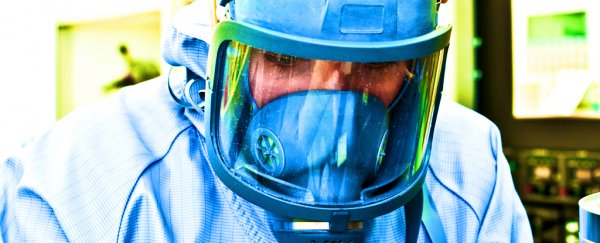In the year 1980, the world achieved a major victory. Smallpox, a devastating and often deadly infectious disease that had plagued humanity for centuries, was declared eradicated.
Things have changed since then. Strictly speaking, the only officially known stock of the virus that causes smallpox is contained in two high-security biosafety labs in the US and Russia. Unofficially, though, it's a different story.
In 2017, scientists in Canada caused an uproar when they stitched together a synthetic version of an extinct horsepox virus in the lab, using mail-order scraps of cloned DNA.
This controversial chimera wasn't smallpox, but it – and the techniques used to spawn it – were similar enough that critics warned the world was now more vulnerable to a reemergence of the smallpox scourge.
Over these kinds of fears, the US government went as far as approving a drug last year to treat smallpox – a disease that doesn't even currently exist – in case it ever does reappear through some kind of bioterrorist attack.
To investigate what this kind of hypothetical threat might look, scientists in Australia recently led a complex international simulation of such an attack, called "Exercise Mataika".
"Using mathematical modelling of smallpox transmission, we simulated a worst-case, large scale bioterrorist attack," explains infectious disease epidemiologist Raina MacIntyre from UNSW in Sydney.
The simulation, conducted in August last year and now reported in two separately published scientific reports (here and here), anticipated what might happen if an engineered smallpox attack occurred in the Asia Pacific region.
The scenario starts in Fiji.
"A first case of haemorrhagic smallpox occurs in a private hospital in Fiji, but the diagnosis is missed, as clinicians are not familiar with the disease," researchers explain, in a summary of the exercise.
"It is not until multiple cases are reported to the Ministry of Health and Medical Services that smallpox is considered as a diagnosis."
Thanks to modelling used to underpin epidemic projections, the hypothetical outbreak spreads to 200 people, with a fatality rate of about 40 percent.
The local health system becomes overwhelmed, and media reports produce a mass panic. It takes 13 days for the smallpox virus – variola major – to be identified.
The World Health Organisation (WHO) declares an emergency and begins deploying vaccines, while Interpol identifies the outbreak as a bioterrorism attack.
Airports and ports start to close, but with over 2,000 cases and many doctors now dying, nurses call a strike. Then, as 32,000 vaccine doses arrive in Fiji, a larger scale attack occurs in a much larger and more populous country in Asia.
"In a worst-case scenario, at the peak of the epidemic, worldwide, only 50 percent of smallpox cases are isolated… and only 50 percent of contacts are tracked and vaccinated, causing a catastrophic blow-out in the epidemic," the researchers explain.
"Under these conditions, modelling shows it will take more than a billion doses and 10 years to stop the epidemic."
Things get worse.
"In the final phase of the epidemic, which becomes a pandemic, the workforce is decimated, leaving critical infrastructure, transport, power, communications and food supplies compromised," the authors write.
"Trust in government and authority structures has disappeared, and legitimate attempts at communication by authorities are viewed with suspicion and fuel conspiracy theories."
Thankfully, this catastrophic scenario remains purely hypothetical for now, but experts say we need to run tests like this – especially since they indicate how unprepared we are for what could one day happen for real.
"We must recognise the challenge that this situation presents to society," explains biosecurity expert Michael Osterholm, the director of the Centre for Infectious Disease Research and Policy (CIDRAP) at Minnesota University, in a commentary on the research.
"The results of the exercise are sobering… the results and lessons learned should be considered by every country in the world."
The findings are reported in Global Biosecurity here and here.
